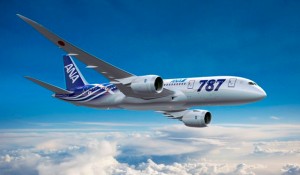
This is what the special livery will look like on the first 787 to be delivered to ANA (ZA101).
Boeing and ANA will be unveiling the special livery on the first Boeing 787 Dreamliner to be delivered, hopefully by the end of September. Boeing has stated the aircraft (ZA101 – Airplane #8) should be rolled out of the paint hangar located at Paine Field at about 3pm PT. You can follow the events live via Twitter (you do not need an account to follow – what is Twitter?):
* My Twitter feed: @AirlineReporter
* Jon Ostrower: @FlightBlogger
* Boeing’s Official: @BoeingAirplanes
* Everyone Tweeting about it: #ANA787
I plan to do a quick post with a photo when it is reveled and then a post later this evening with many more photos, then a later post with a video tour of the interior of the ANA Boeing 787. Stay tuned…

Boeing Dash 80 barrel roll above Seattle Seafair, August, 1955. Photo from Boeing. Click for larger.
If you haven’t seen the video of the first Boeing 707 (called the Dash 80 at the time) completing a barrel rolled by legend Tex Johnston, you might not fully appreciate this photo to the fullest. From Boeing’s Flickr page:
“In August, 1955, Boeing test pilot Tex Johnston performed a now legendary barrel roll of the Model 367-80 as part of that year’s Seafair festival on Lake Washington. This photo was taken by co-pilot Jim Gannett.
Known as the Dash 80, this airplane was the prototype for the 707 commercial plane and KC-135 military refueling jet.
The 707 helped move commercial aviation into the jet age and was the first to carry the now iconic “7 series” Boeing model designation.
The Dash 80 today is displayed at the National Air and Space Museum Steven F. Udvar-Hazy Center outside Washington, D.C.”
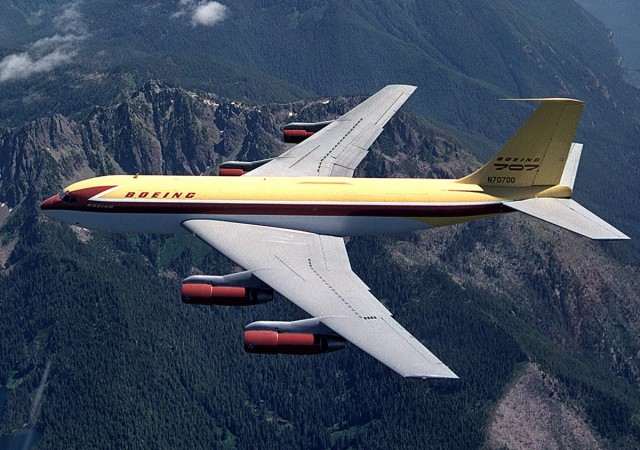
This is the first Boeing 367-80 (Dash 80) was the prototype for what became the KC-135 and the Boeing 707. Photo by Boeing.
The punch-line is that Boeing did not know that Tex was going to do the barrel roll. The idea was to show the public and potential airline customers that the 707 was safe. From a previous interview with Boeing Historian Michael Lombardi, he explained, “Then you have Tex Johnson who did the barrel roll, doing his part to get people feeling that jets were safe’¦ that was the whole idea. Before that the British had come out with the Comet and it had a few problems. Because of the comets problems, coming apart at altitude, the public view of jets was that they were just not safe.”
Seattle’s Seafair is going on once again this weekend and the Boeing 747-8 is scheduled to fly on Sunday, August 7th at 3:50pm over the crowds, much like the Boeing 707 did 56 years ago. Currently, it has not known if it will be the 747-8 Freighter or the 747-8 Intercontinental, but I am hoping for the glowing orange 747-8I. Just don’t expect any barrel rolls!
While I was gone recently, a very motivated young man, Vinay Bhaskara, asked if I might want him to write up a guest post about Air India. When I said I would love one, I had no idea he would be so detailed and really re-construct the history of the airline. Things kept popping up and I wasn’t able to share his multi-part story until now.
Bhaskara is a teen-aged aviation enthusiast and blogger. His blog is hosted at Flyertalk (The Gate). He can be found on Twitter (@TheGateVinay), as well as Facebook and Linkedin. His podcast on Asian aviation should also be launching soon. Here is his story on Air India in his own words:

Air India's first aircraft was the de Havilland Puss Moth.
The Air India Story- Part 1
Air India is one of the most confounding airlines in the world today. Once India’s flag-bearer to the world; the aging carrier has slowly disintegrated into the mess currently grabbing headlines today. Such staple routes as Tokyo, Frankfurt, and London just aren’t making money for the carrier; a far cry from the days when they brought the Indian flag to every inhabited continent on the globe except South America. But in order to understand its current problems; it would be helpful to take a look back into the past.
The Early Days
Air India (and its former domestic partner Indian Airlines) has its roots in the vision of J.R.D Tata; India’s first true business scion. Tata was a director at Tata Sons Limited; one of Asia’s largest industrial companies. In July of 1932, he created an aviation department at the company; and began the first un-subsidized (ie: no mail contract from the British) domestic air service in India after receiving a license for through flights between Madras (Chennai) and Karachi via Bombay (Mumbai) on October 15th, 1932. The route, which also stopped in the commercial city of Ahmedabad gave South India an important link into the airline network in Bombay. The initial fleet consisted of 2 Puss Moths; a 2-3 seat propeller aircraft. Such was the success of the carrier that they added an additional Fox Moth; a larger cousin of the Puss Moth that could carry 3-4 passengers, within a year.
By 1935, a technical stop in Bellary had been replaced by a passenger stop in the more important Southern city of Hyderabad and overall frequency had doubled from once weekly to twice. New routes were also on the radar of the rapidly growing carrier; November of 1936 saw service being expanded from Bombay to Trivandrum via Goa using a 5 seat Miles Merlin, which Tata had used to replace the Puss Moths. By 1937 a route to Delhi (via Indore, Bhopal, and Gwalior) had been started and in 1938 the route to Madras was extended to Colombo, Sri Lanka. Tata Airlines’ business got a big boost during this period from a mail contract with the British Empire Air Mail Scheme, under which all First Class Letters between Karachi and Colombo (and all points served in between) were carried by Tata Airlines at ordinary postage rates (on a pound-mileage basis). By 1939; Tata Airlines was operating a fleet of 8 passenger D.H.89s and smaller types from the American manufacturer Waco; in that same year- the carrier bought two 12 seat D.H.86s from Mac.Robertson-Miller Airlines in Australia. But due to the outbreak of World War 2; J.R.D Tata was unable to take Tata Airlines to greater heights.

TATA's time table during the summer of 1935. Photo from Wikipedia.
During World War 2; the growth in new routes slowed for Tata Airlines. But because the War was relatively docile in India; demand on existing routes continued to grow. They upgraded their fleet constantly; eventually jumping up to a fleet of 3 Stinson Model As, as well as multiple 14 seat Douglas DC-2s. This new lift helped Tata spread its wings to Bangalore, Nagpur, Calcutta, and even Baghdad, Iraq by June of 1945 (nearing the end of the war).
Following the end of the war; Tata Airlines switched its emergency (ie: for war) route permits with actual route rights from the government. All routes were confirmed by June; and Tata was given access to war surpluses; resulting in a large fleet of at least 12 Douglas DC-3s; an aircraft which formed much of the fleet of Asian carriers in the 1950s. On July 29, 1946; Tata took his company public; and the carrier was re-named Air India Limited. In April of 1947; Air India received the first of 4 35-seat Vickers Vikings; for use on the larger routes in their network. As Air India continued to grow; it became a government owned corporation in March of 1948; later that month they received their first Lockheed Constellation; a large turboprop.
Running in parallel to the expansion of Tata Airlines were a few other Indian domestic carriers; such as Indian National Airways (INA) and Air Services of India (ASI); both of which had domestic networks rivaling that of Air India Ltd. Smaller private players abounded as well; Bharat Airways’ network extended all of the way to Bangkok, Hong Kong, and Singapore. As the government searched actively for ways to strengthen the Indian aviation industry; the nationalistic undercurrents in Indian politics called for a single national domestic airline. They got their wish on June 15th, 1953 when all Indian domestic carriers; as well as the domestic arm of Air India Ltd. were merged to form the Indian Airlines Corporation. The resulting carrier had a fleet of over 100 aircraft; ¾ of which were DC-3s, as well as a dozen each of the larger DC-4s and Vickers Vikings. Air India Ltd. was re-organized as Air India International (AII- later shortened to Air India), and given exclusive rights (amongst Indian carriers) to carry long-haul international traffic.
*From this point on; the stories of Air India and Indian Airlines will be told in parallel.
The Expansion
Before losing its domestic operations to Indian Airlines, Air India had also pursued its own international expansion. Soon after receiving the first Constellation, Air India introduced service to London; by way of Cairo and Geneva. Despite strong initial demand however, Tata was cautious, and he limited Air India’s initial international expansion to London and Nairobi (via Aden, Yemen) with its large ethnic population of Indian businessmen. But progress was not to be held back. The London services quickly jumped in frequency to 3 flights per week and new European points were added quickly to the London route; Rome, Paris, and Dusseldorf. Though Air India grappled with the time savings of the new Comets flown by BOAC (they even ordered a pair); they fought back with superb on-board service. Air India was especially beloved for the humorous little booklets it handed out to every passenger; with such useful information as how to (not) steal cutlery and a reminder not to stuff children in seat-back pockets.
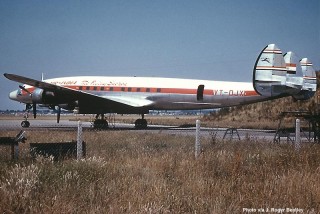
An Air India Super Constellation (VT-DJX) Photo by: J. Roger Bentley
Despite the lack of jet service to compete with BOAC; marginal improvements came with Lockheed’s L-1049 Super Constellations; which were placed on the London route in 1954. By 1960; the London route included Beirut, Zurich, and Frankfurt (which had replaced Dusseldorf. But in addition to an expansion of European service; Air India was turning its eyes eastward; to the Orient. Within a few years of full nationalization (1953 in parallel with Indian Airlines); Air India had opened routes to Singapore, Hong Kong, and Bangkok. The Singapore route was quickly extended to Australia (Sydney by way of Darwin); picking up traffic stops in Kuala Lampur and Jakarta along the way. Because of the violence in Egypt during the Suez crisis of 1956; Air India also developed an alternative route to Europe (Moscow by way of Tashkent); which could be extended to Western Europe if necessary. As the 50s drew to a close; Air India had grown from infancy into a full-fledged international carrier; with wide-ranging operations in Europe and Asia, as well as important toeholds in Africa and Australia. It was the latter that allowed Air India to take advantage of a lucrative business opportunity in the late 1950s; it leveraged its important position on the Kangaroo route to launch a revenue-sharing agreement with Qantas and BOAC (sort of a pre-precursor to today’s JVs) on service between Europe and Australia.
Meanwhile; Indian Airlines had been quietly dealing with problems of its own; mainly related to the fact that 8 airlines; with differing operations, had been squished into 1. Especially problematic was the redundancy in jobs; the airline had 2-3 times as many employees as necessary- resulting in a bureaucracy of staggering inefficiency. The attrition process would take many years and was never fully completed (see Air India’s current situation). Furthermore; the fleet of DC-3s was maintained haphazardly; with quality in certain shops shockingly bad (to put it mildly). This in and of itself was a more fundamental problem; as a carrier with a reputation for being unsafe could not be expected to gain flying passengers from the nation. When coupled with a bevy of unsafe airports (unpaved runways etc.), at least 17 resultant accidents involving DC-3s took place in the first 3 years of Indian Airlines. But while Indian Airlines grappled with these problems; they also moved to modernize the fleet. Five Vickers Viscount 768s were ordered for the main trunk lines and 8 de Havilland 114 Herons were introduced onto feeder routes.
During the 1950s; Indian Airlines set its network into a pattern that would be followed till the 1990s. The major trunk lines (especially those connecting ’œThe Diamond’- India’s 4 largest cities; Bombay, Calcutta (Kolkata), Delhi, and Madras) were operated with the largest aircraft. Initially, they were served with Vickers Vikings; but trunk routes quickly shifted to pressurized Viscounts in 1957. Secondary routes were served initially with DC-3s; though even these routes could be differentiated into two tiers (Tier 1: mid-sized Indian cities with modern airport facilities, Tier 2: small Indian towns with rudimentary airstrips). As Indian Airlines shifted into the 1960; their main fleet problem became dealing with a replacement for the ageing DC-3s. The venerable Dakotas were the only airliner that could operate on rudimentary grass and gravel strips; so common in India’s economically backwards Northeast region. Replacement for Tier 1 cities was easy but the fate of Tier 2 stations remained to be seen. Two manufacturers had offerings in the 40-44 seat turboprop market; the Fokker F-27 Friendship and the Avro 748 (later Hawker-Siddely 748s). The HS-748, with its low wing design, was considered the better aircraft for operations into Tier 2 markets, so India negotiated a deal from which HS-748s would be built at Kanpur, India. However, given India’s notorious problems with business, Indian Airlines also decided that it couldn’t wait for the HS-748s for Tier 1 replacement and simultaneously order F-27 Friendships as well. These aircraft were delivered in 1961 (a full 6 years before the first HS-748), and began plying routes across India. But even after delivery of both types; neither was able to replace the DC-3s on the smallest dirt and gravel strips; meaning that the DC-3s stayed in the fleet until 1974.
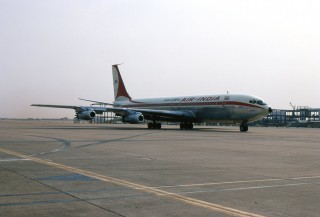
Air India Boeing 707 (VT-DJK) taken in London (LHR) in April 1969. Photo by Sir Hectimere.
While Indian Airlines was grappling with tough fleet choices; sister Air India entered the jet age. When the Boeing 707 entered service in 1958, they quickly revolutionized air travel with their (relatively) quiet and fast service. Air India was no different than most carriers, and placed their first Boeing 707 on the London route in April of 1960, and in May of the same year, hit a milestone with entry into service between London and New York; becoming the first Asian airline to serve NYC. Air India was considered one of the most luxurious airlines in the world; with its unique brand of Indian service creating popularity not only from New York to India; but even on the trans-Atlantic crossing. Much of Air India’s extraordinary service reputation during the 60s and 70s was the result of the work of Bobby Kooka, a marketing executive whose credits include the venerable Maharaja logo (the symbol of Air India).
By 1962, the 707 had replaced the Constellations (which were converted to cargo service) on the routes to Tokyo, Australia, Africa, and Europe; Air India was now an all-jet airline. Throughout the 1960s; Air India rationalized its network to fit the changing airline world. The advent of jet travel allowed more routes to be operated than ever before. This led Air India to de-couple much of its European network (though almost all flights ended in London), and add service to more points in the Gulf and beyond. By the second half of the decade; Air India had begun to shift its network to meet the needs of the changing overseas Indian population. Flights to Europe declined in importance, as the 707 allowed Air India to expand its network. The island destinations of Fiji and Mauritius, where Indians composed 50% or more of the populations, entered in 1964 and 1967 respectively. In 1968 they added Entebbe and Addis Ababa as African points; both containing sizeable Indian population. But these additions could not compare to the sudden boom in Indian population that was taking place just across the Arabian Sea. The Muslim countries of the Gulf were experiencing an oil boom, with their economies growing in the double digits each year. In order to service this growing wealth, these countries imported hundreds of thousands of laborers from South Asia to build up their infrastructure and serve as domestic servants. While these laborers were not supremely wealthy, they did constitute a source of new and growing demand. Recognizing the need for direct India-Gulf services; Air India began operating to many Gulf points as stand-alone destinations. Dubai, Abu Dhabi, and Dhahran soon showed up on the route map; and such was the demand for Air India’s services that they even chartered a Vickers VC-10 from BOAC to service Kuwait. Air India’s 11 Boeing 707s stayed in the fleet until the 1980s; operating on secondary routes and serving as a valuable tool in opening new services.

Air India Boeing 747-200 (VT-EBO). Photo by Savvas Garozis.
Indian Airlines too was quick to enter the Jet Age. The Friendships had been successfully deployed on secondary routes, but it had quickly become apparent that the Viscounts were far too small for their main trunk routes. Two choices were possible; the British Trident and the French Caravelle. The Caravelle; with its bold rear-engines was the world’s first short-haul jet and it had served Air France with distinction. The Trident, on the other hand, was a paper airplane that carried only a few more passengers than the Caravelle with far more inefficiency. The Caravelles entered service on Indian Airlines’ trunk routes by 1964, equipped with 89 all-economy seats. In spite of the Caravelle’s extraordinary performance (Indian Airlines achieved annual utilization of almost 3,000 hours per aircraft- among the best in the world), problems with accidents persisted; and Air India lost 2 Caravelles in 1966. By 1968/69 Indian Airlines was in a severe capacity crunch (though the HS-748s helped some); further exacerbated by extraordinary demand on their trunk routes (which the Caravelles couldn’t fill). So in 1970, Indian Airlines won approval from the government to order a larger jet. The 125 seat Boeing 737-200 won the contract and 7 frames were ordered in 1970. However, this order was not without controversy; as the Douglas DC-9 and the BAC 1-11 were both in contention. The complicated and messy battle ended with the 737-200’s selection; and Indian Airlines received an aircraft that would remain the workhorse of its fleet into the 90s.
Thus concludes part one of The Air India Story; which covered the dual story of Air India and Indian Airlines from ~1930 till 1970. Part 2 will cover the B-747 era, as well as Indian Airlines into the 2000s. Part 3 will cover the current situation at Air India and its possible solutions
Image Citations:
de Havilland from Air India
Route map from Wikipedia
Constellation by J. Roger Bentley
Boeing 707 by Sir Hectimere
Boeing 747 by Savvas Garozis
Last Friday I showed off Boeing’s 360 view of a Boeing 737 (nicknamed the “gigaplane”) and asked how many photos it took to make this one of a kind view. When the first few “around 20,000” answers started rolling in, I thought people were pretty good. Then I realized that other sites and even Boeing had covered the 360 view and stated it was “around 20,000.” I guess I cannot blame people for doing research, but luckily the “real” answer is not an even 20k — I do not have that many prizes.
So what is the exact answer? According to Boeing it is 22,240.
There were a lot of guesses and I appreciate the involvement, but who got closest? Well, I am giving props to the two who were the closest: Ariff Shah from Moscow who was only off by 240 and Allen Cheng from Langley, BC who was off by 260. So what do they win besides uber props on the blog?
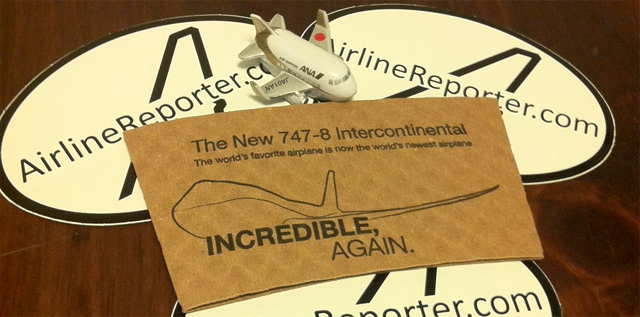
These are the fabulous prizes for the Boeing 737 360 giga-plane contest. Good stuff.
They will both be mailed the prizes above: three AirlineReporter.com stickers, one magnet of an ANA Boeing 737 and last, but surely not least a coffee cup holder I got during the first flight of the Boeing 747-8 Intercontinental. For the average person, the paper coffee holder means nothing, but for the true aviation geek, this is gold.
The video above shows behind-the-scenes on the making of the gigaplane image created by Boeing. It seems that fans are not the only ones excited about the giga-image. Rahsaan Johnson, the Director of United’s Communications told AirlineReporter.com, “Boeing is a great partner and the 737 is a great airplane, so we’re happy to join them in showing it off.”
A huge thanks to Boeing for creating and sharing this image with the general public — I hope we see more like it in the future.
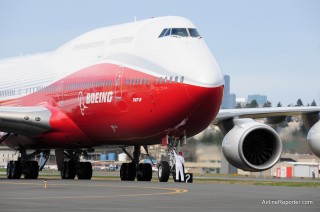
The first Boeing 747-8 Intercontinental after landing at Boeing Field after her first flight.
Some media outlets are reporting that the FAA partial shutdown could affect the certification of the Boeing 787 Dreamliner, the 747-8 Freighter and 747-8 Intercontinental. According to Boeing, as of now, the partial shut down will not affect the certification of the aircraft, but could affect airports looking to be certified to operate the new 747-8.
“The FAA says airplane certification activities will continue– so we don’t expect any impact there,” Boeing spokesperson Doug Alder Jr explained to AirlineReporter.com. “As for airport certification, if furloughed FAA personnel don’t return to work in time to finish the remaining airport approvals for the 747-8, customers wouldn’t be able to fly the airplane into certain airports until that work is complete (SFO, Newark, O’Hare and Houston are the major ones).”
This is just another reason to be angry at the partial FAA shutdown.









